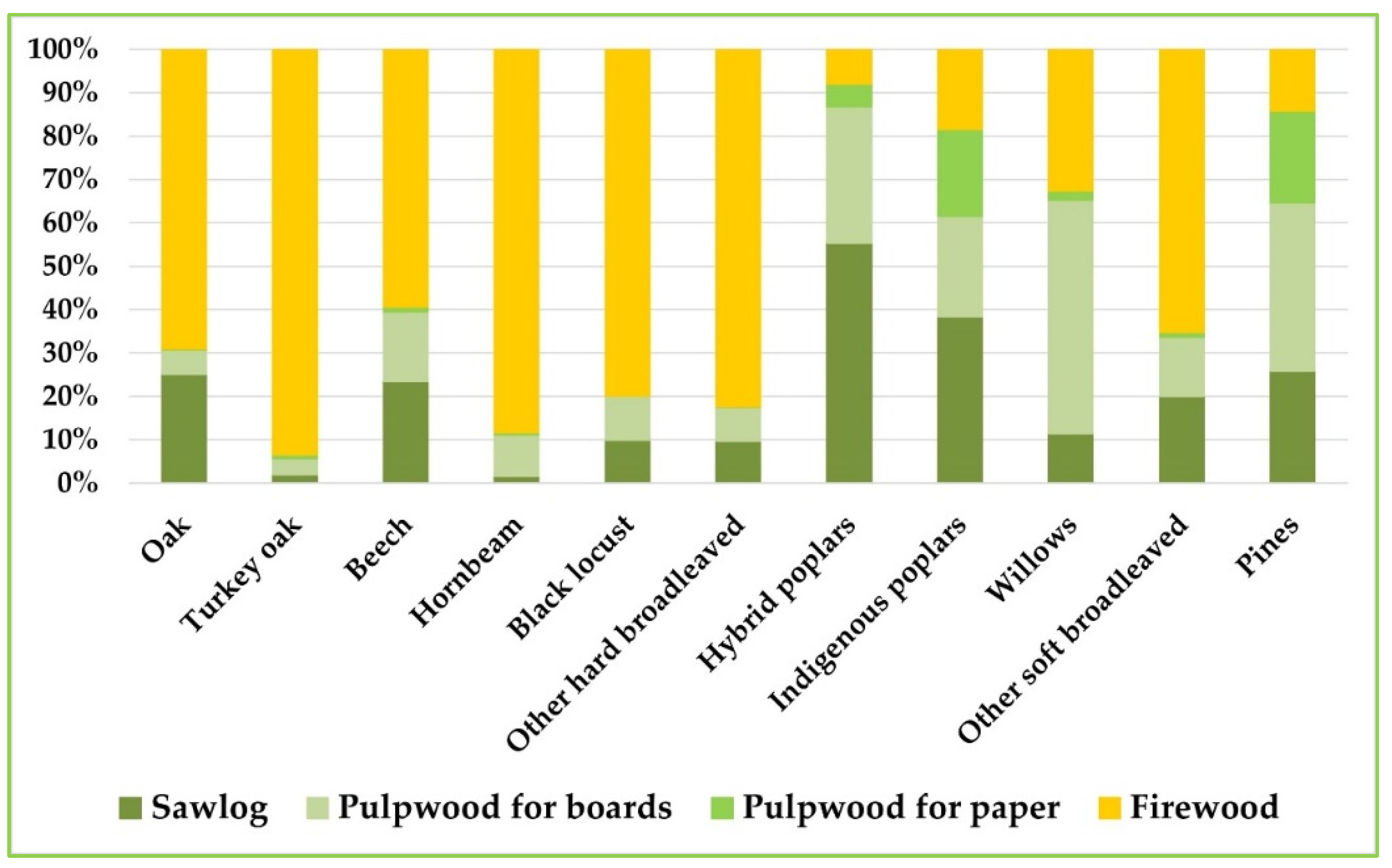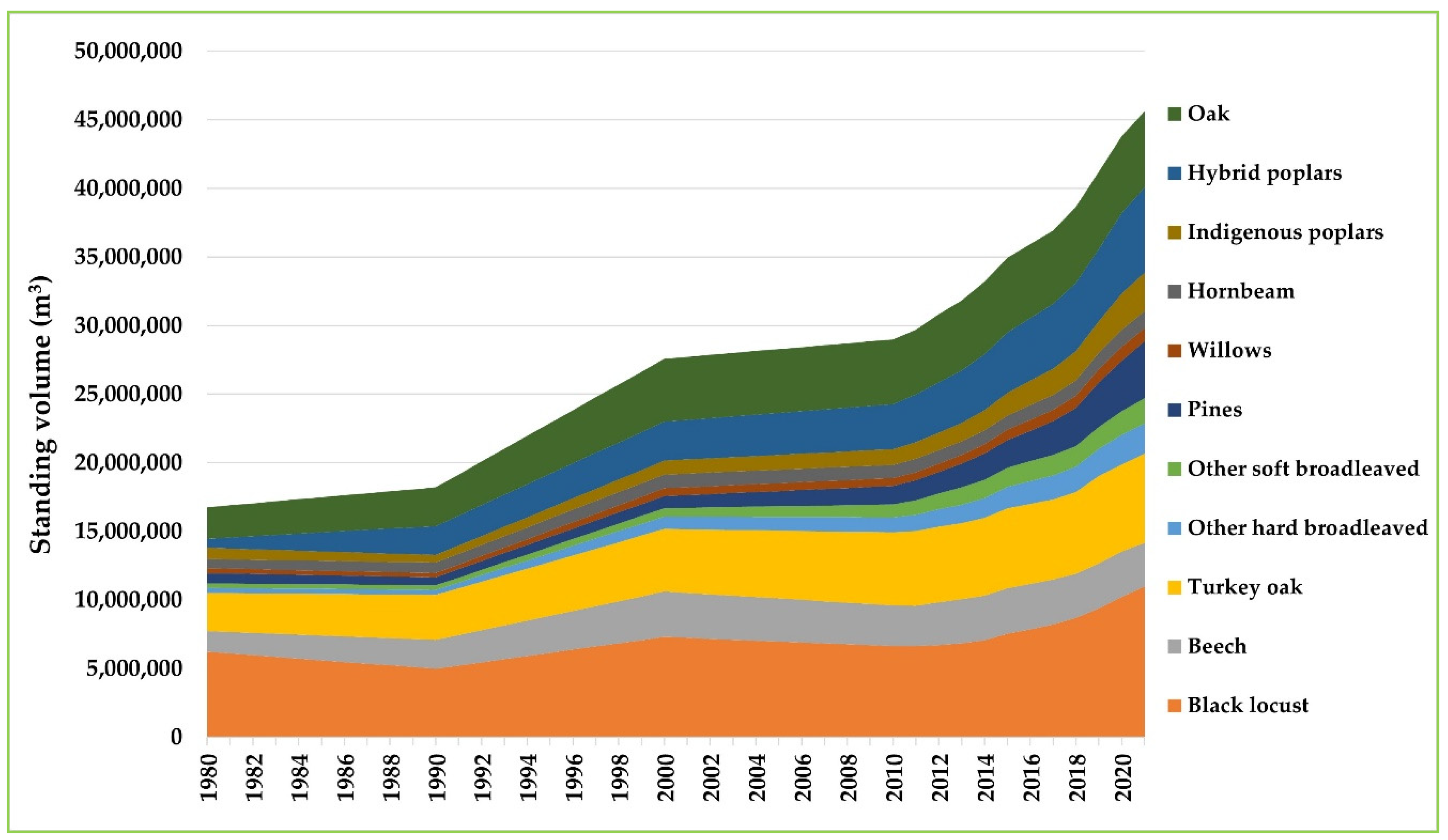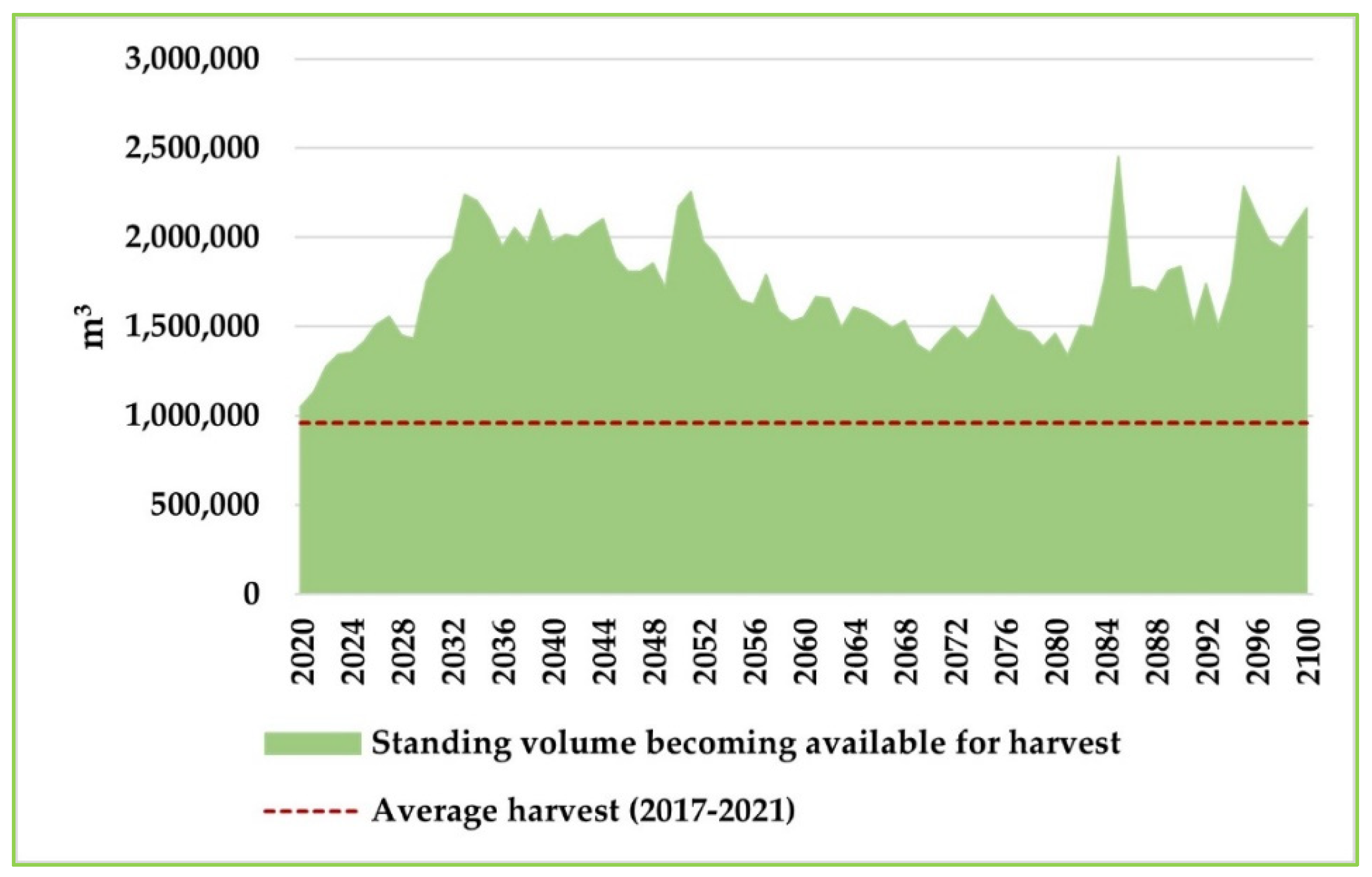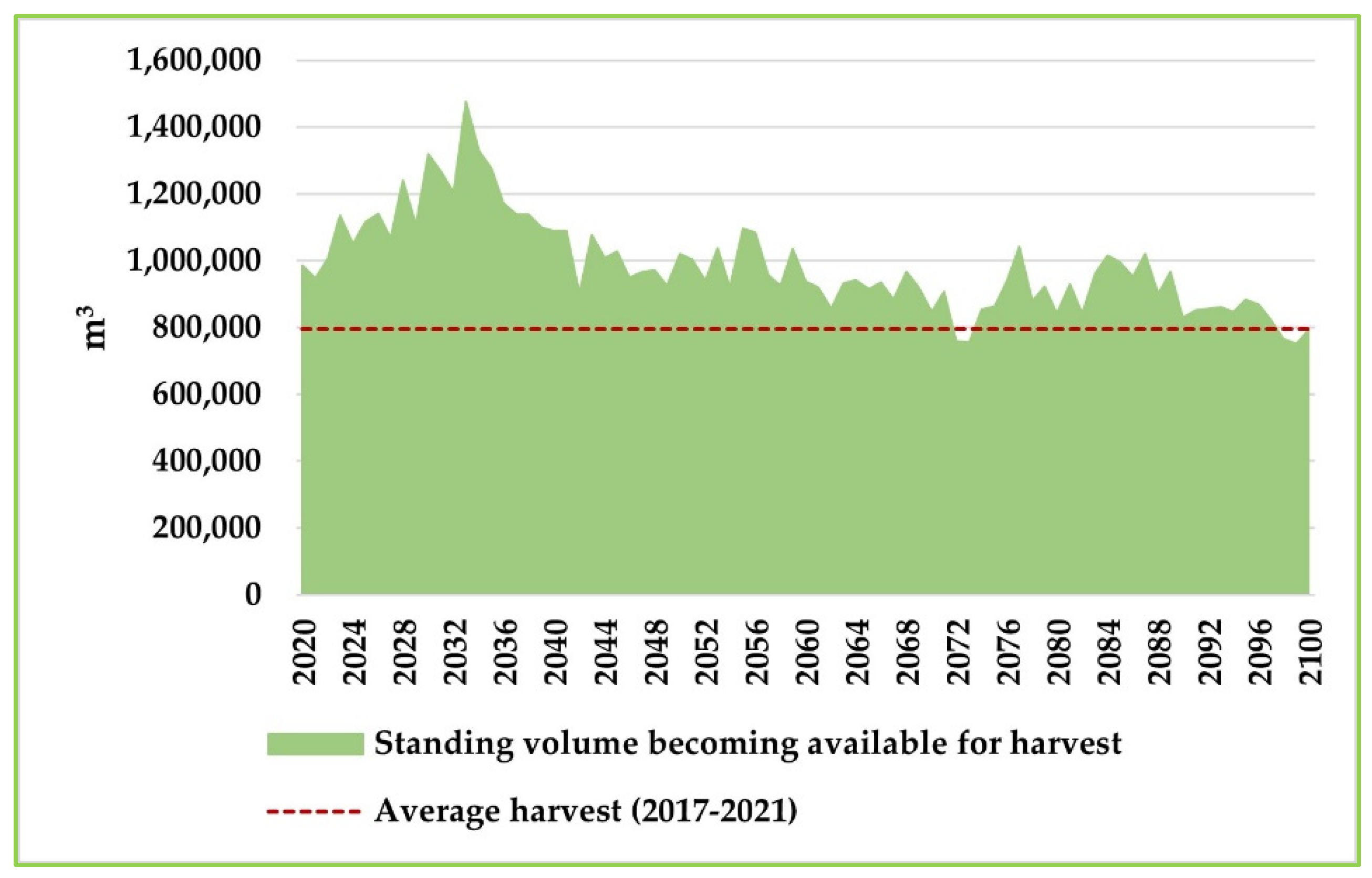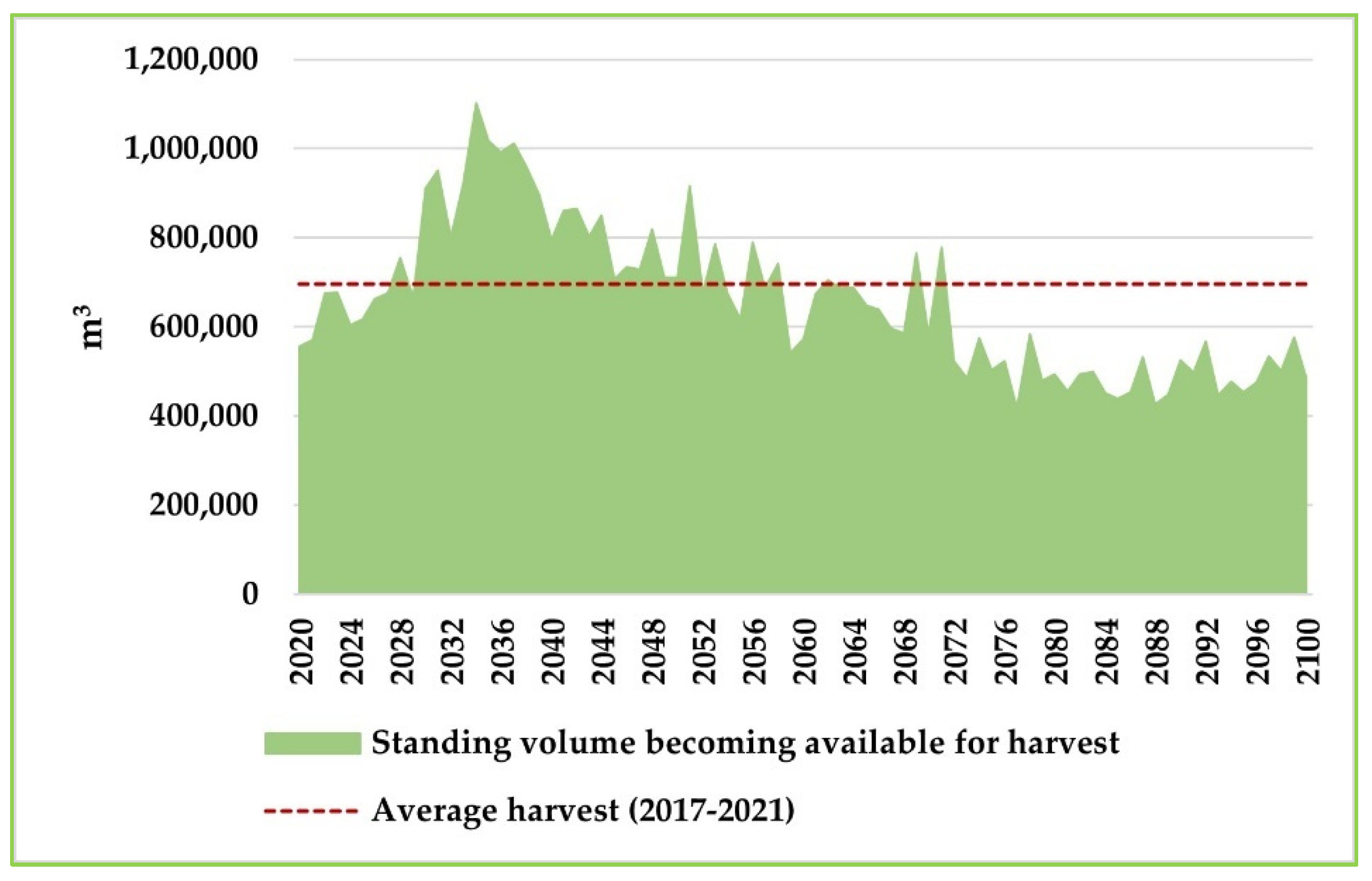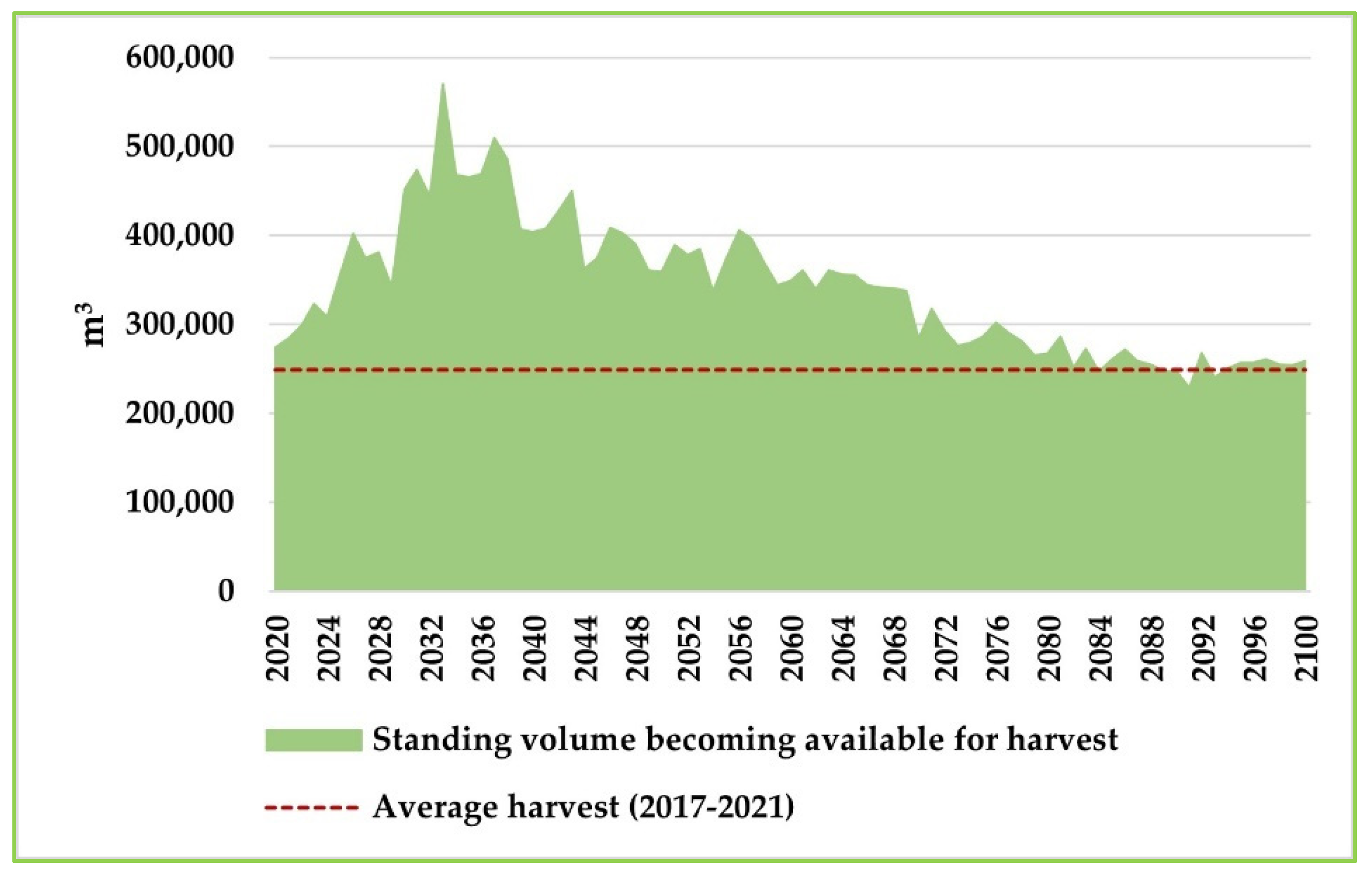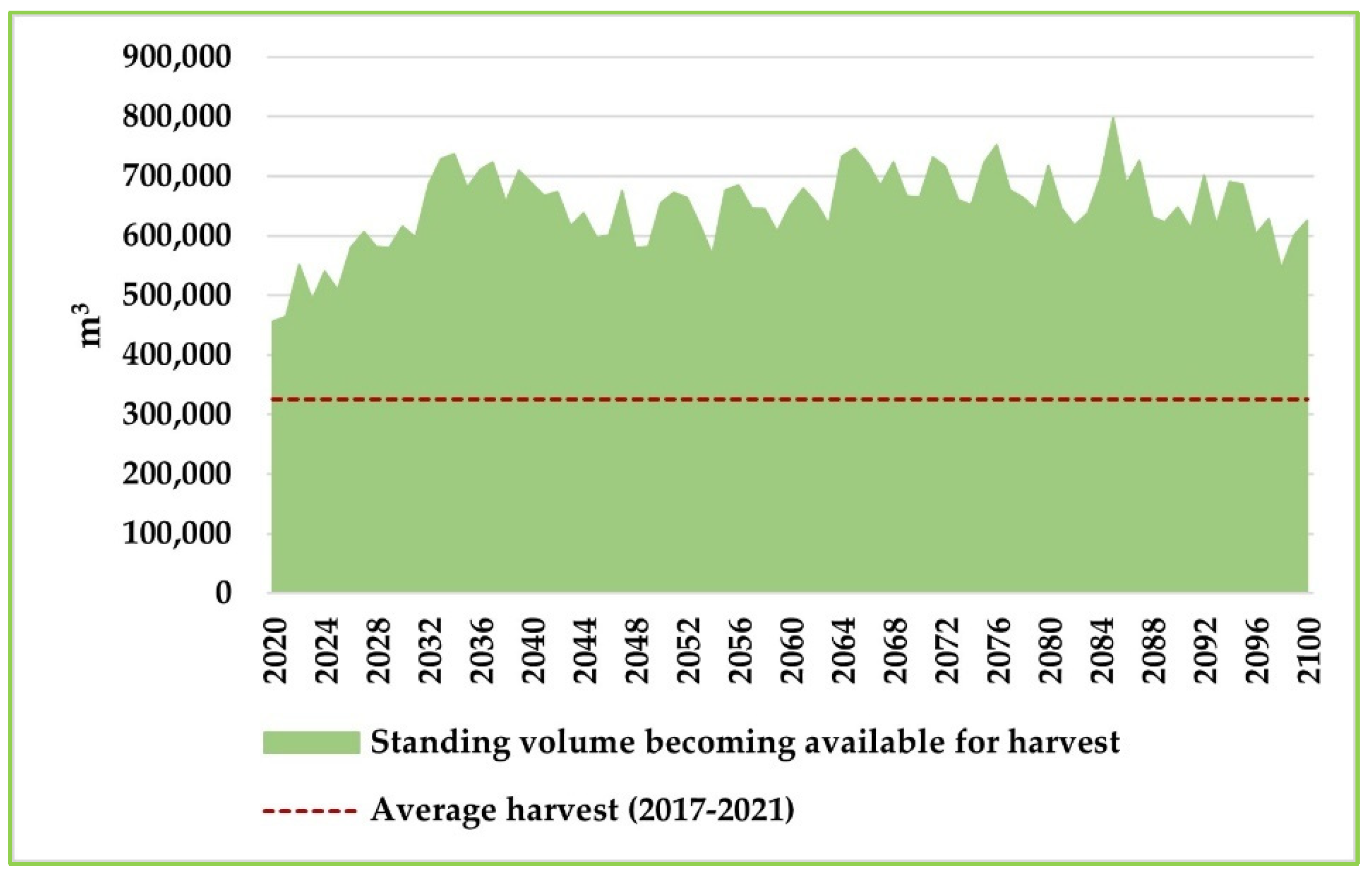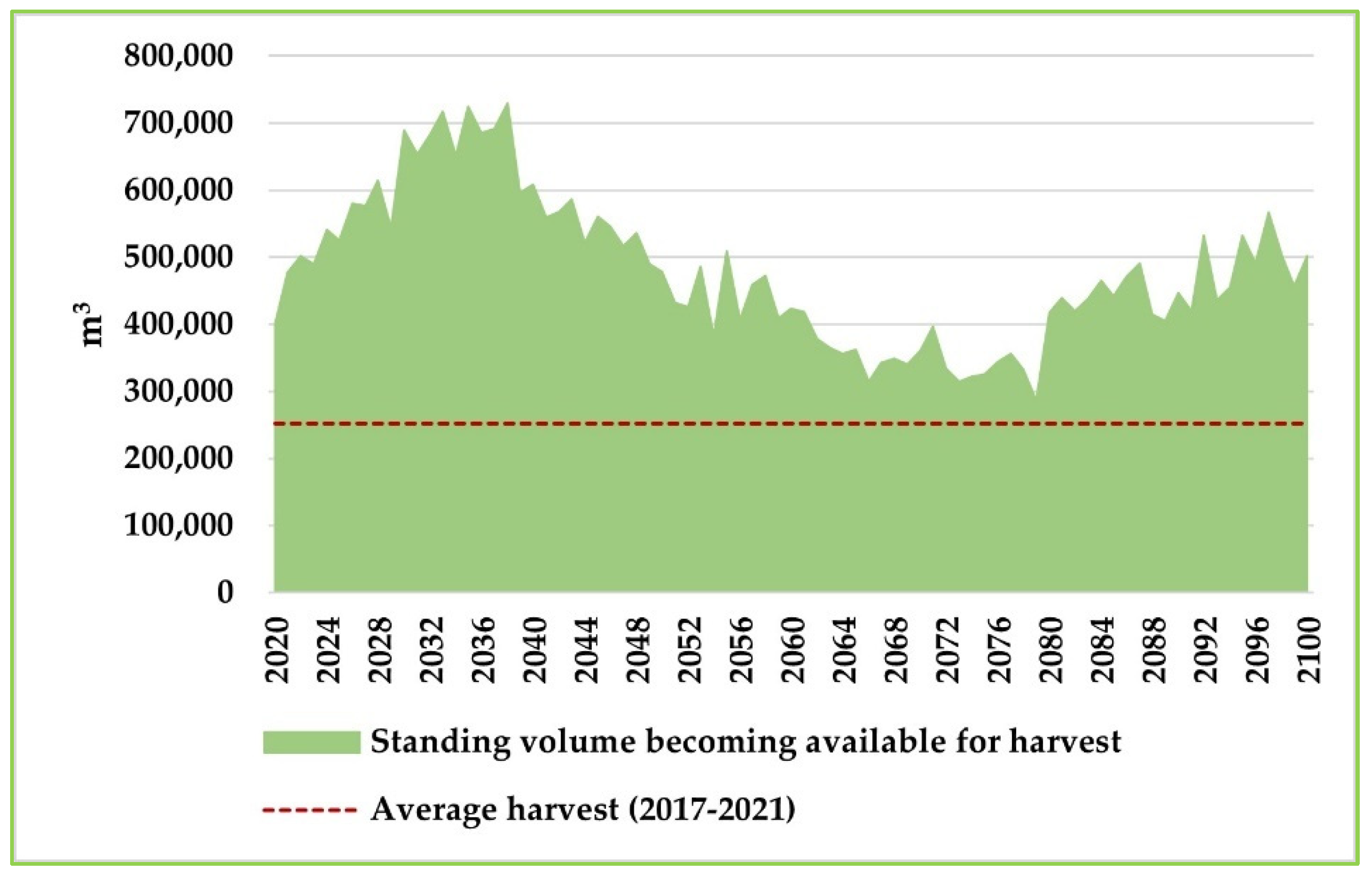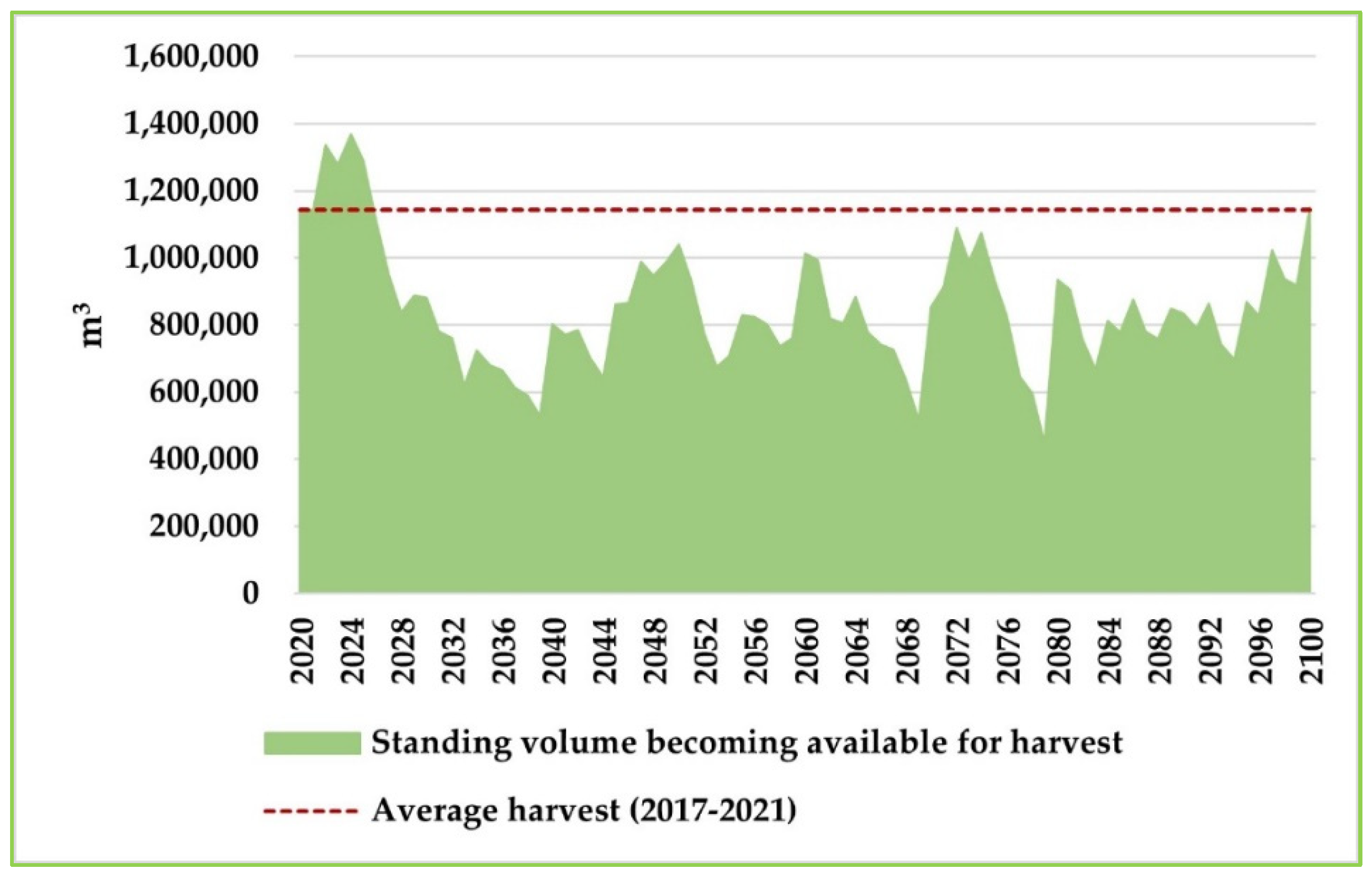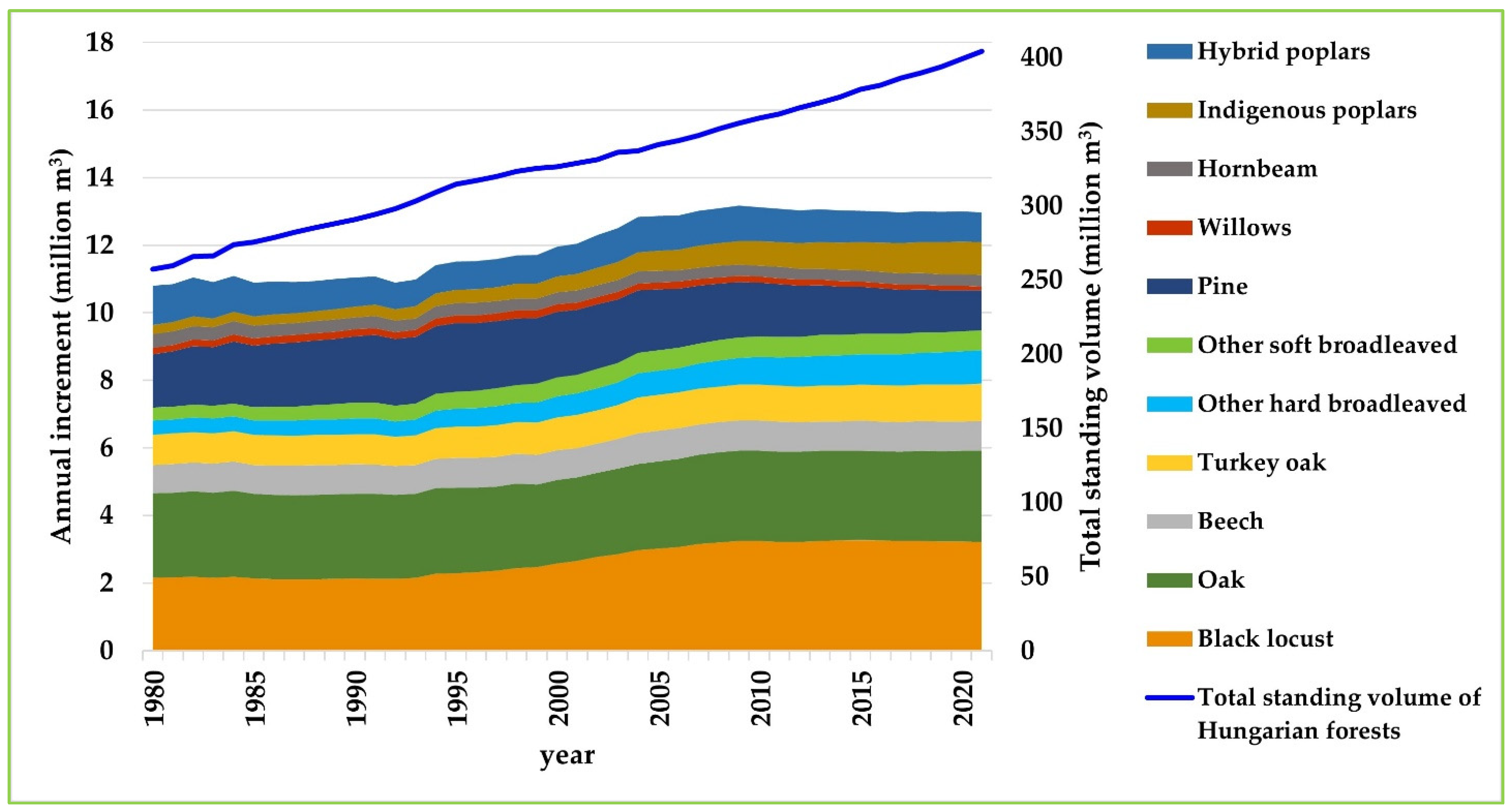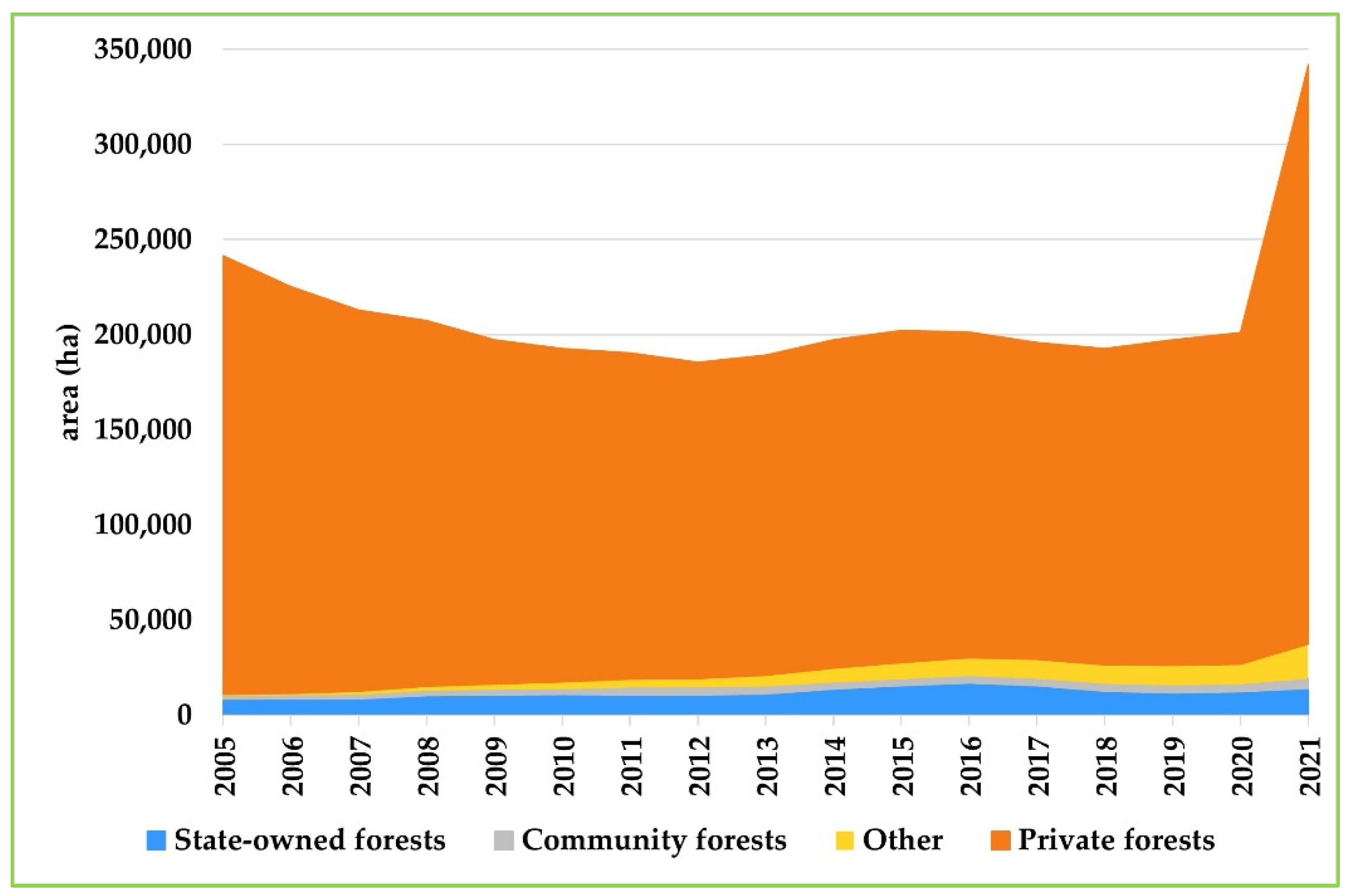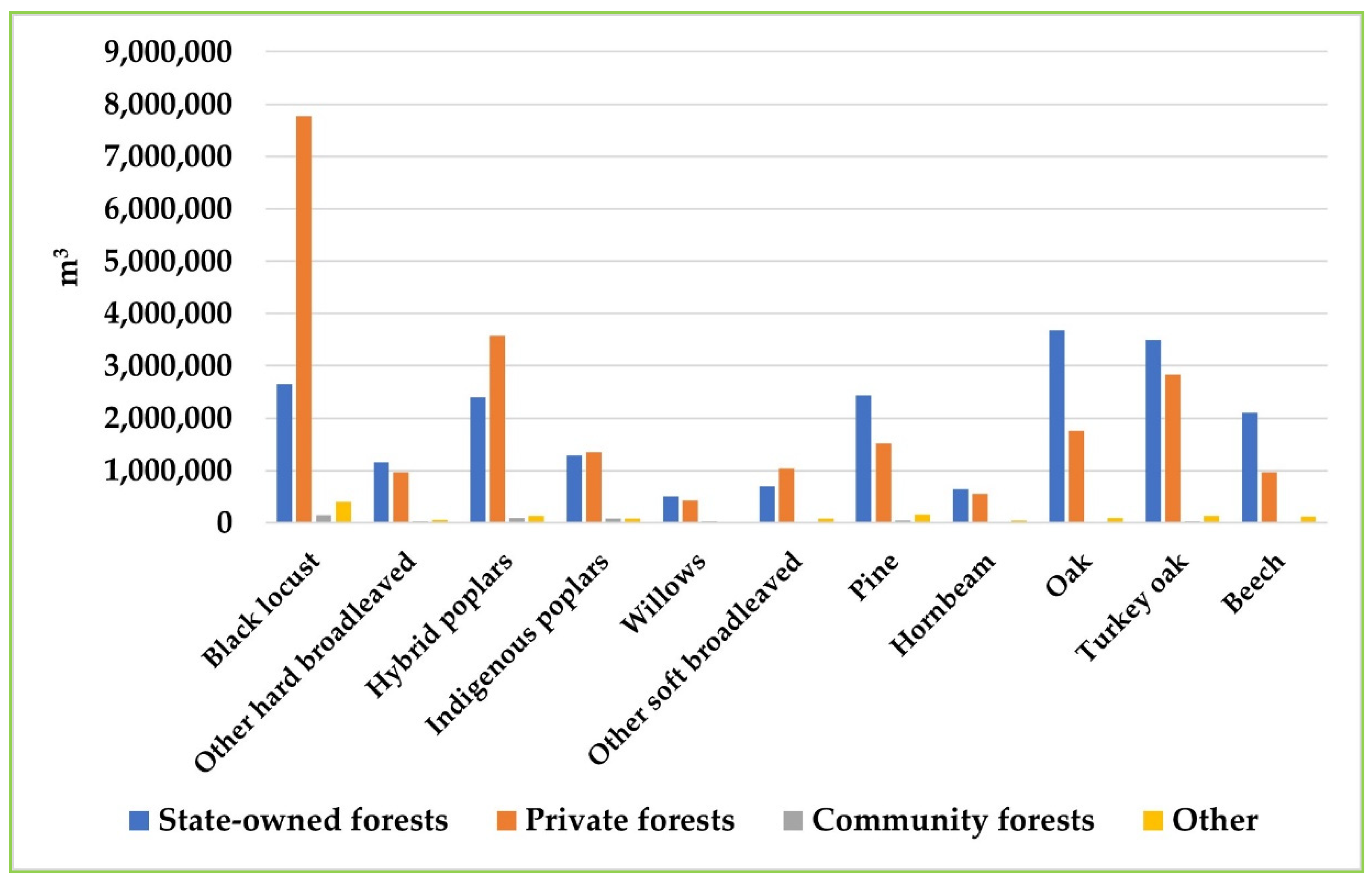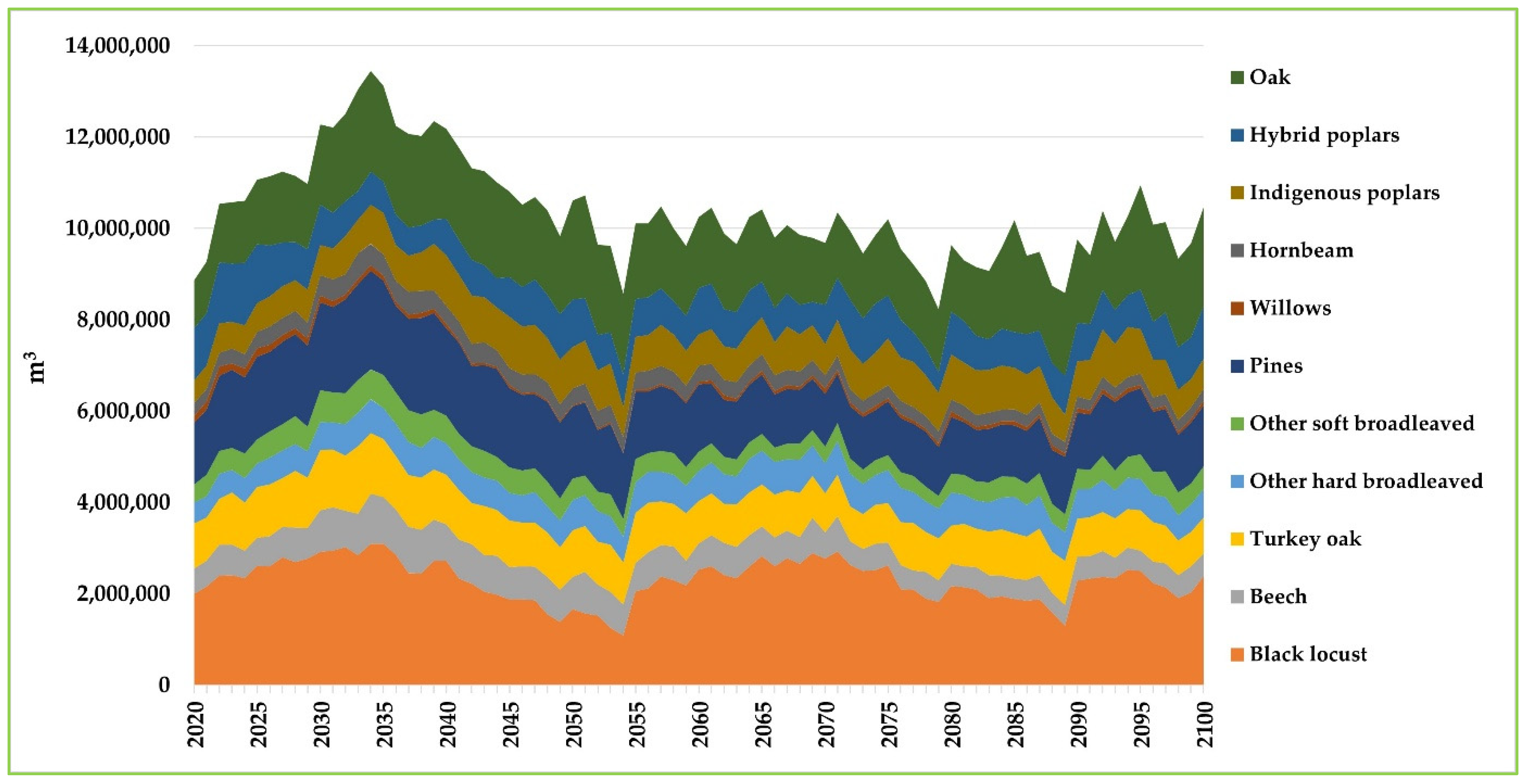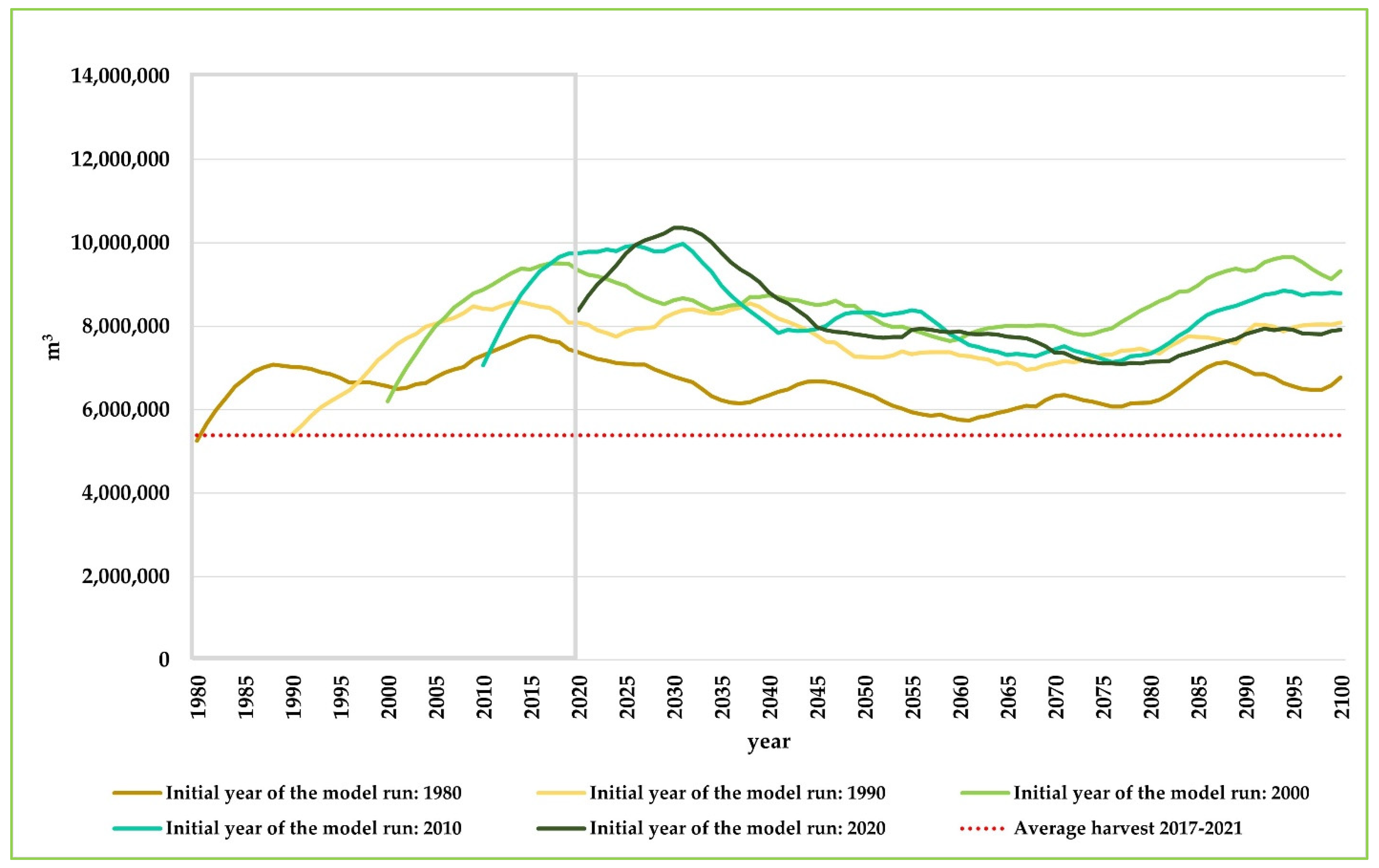1. Introduction
Sustainable forest management is a key concept that underpins modern forestry practice by recognizing the need to balance the social, ecological, and economic outputs from forests [
1,
2]. The contradictory goals of economic efficiency and nature conservation, and the competitive uses of the wood yield as raw material for wood products, as source of renewable energy or as carbon storage in the standing volume can only be balanced with careful planning and foresight [
3].
The EU bioeconomy strategy aims to increase the use of wood for bioenergy and in long-lived wood products, especially in the construction sector [
4]. The demand for woody biomass as a raw material for a wide range of products in the developing bioeconomy is expected to increase, and this has led to the need of increased timber productivity and the search for new procurement methods and new assortments and innovative supply chains [
5,
6]. With the rising feedstock demand, wood supply security is an increasingly pressing topic, and many doubts accompany the resource potential of hardwoods and their softwood substituting potential within their material utilization [
7]. Under a biobased economy, the global demand for wood is projected to increase with 4.2 billion m
3 until 2030 [
8,
9], and an even higher increase rate in wood demand is expected for the EU countries [
10].
Despite the bioeconomy goals and the growing demand for timber, the European forest strategy [
11] and the biodiversity strategy [
12] do not favor an increase in wood harvest stating that until 2050 the potential additional benefits from harvested wood products and material and energy substitution are unlikely to compensate for the reduction in the forest carbon sink [
13]. However, this argument ignores that carbon dioxide released from forest biomass is part of the continuous terrestrial carbon cycle. Climate change poses an increasing threat to the stability of forest ecosystems in Europe [
14], which means that carbon storage in forest standing volume may have limitations. Dead organic matter left in the forest is not a permanent solution either, as it is returned to the atmosphere by the decomposing organisms in a few decades. Rather than stimulating or focusing on single mitigation activities, policy and management strategies need to consider all the possible forest industry-based mitigation strategies to maximize the contribution to climate change mitigation [
14]. In Hungary, harvested wood products store a significant amount of carbon, and their lifetime extension and appropriate waste management, recycling, and reuse can contribute remarkably to the achievement of climate goals [
15,
16].
Policy demands for the ability to project and estimate future carbon stock changes are also increasing as international agreements require countries to monitor and report on forest carbon stock change [
17]. The Paris Agreement and the Regulation (EU) 2018/841 on the inclusion of greenhouse gas emissions and removals from land use, land use change, and forestry in the 2030 climate and energy framework reflect the expectation that the forest sector may play an important role in mitigating climate change [
18,
19]. As Böttcher et al. [
20] emphasize, the age–class structure is a mirror of the past, and the legacy of past forest management practices might persist for decades after changes in the management (or disturbance) regime [
21]. Tree growth, mortality, and carbon stocks at the stand level are age-related as shown by well-established empirical relationships quantifying the age-dependence of plant productivity [
22,
23] and net ecosystem uptake [
24,
25,
26,
27,
28]. When running simulations with different initial age–class distributions and management change scenarios, it turns out that the legacy effect can be greater than the management change effect itself, and the same management change applied to landscapes with different age structures leads to different carbon trajectories [
20]. With the same management regime, a country with predominantly young forests will see increasing forest carbon stocks, while a country with predominantly older forests is likely to see decreasing carbon stocks in forests, as management change can modify the strength of the sink or source, but the age–class structure legacy affects the direction of stock changes for a long period of time [
20].
Forest growth in the EU has outpaced harvests over the last 25 years and the amount of carbon sequestered by forest carbon sinks currently offsets about 10% of total EU greenhouse gas emissions [
29,
30]. Net carbon stored in the EU forests continues to increase as forest volume accumulates faster than additions to the annual harvest [
29,
30]. This increase in the growing stock arises primarily from the increased density of forests rather than from an expansion in forest area [
13,
30]. Due to the age–class structure of European forests characterized by the predominance of older age classes, additional harvest is possible under the continuation of current forest management regimes as maturing forests are able to sustain higher harvest levels [
31]. Aging forests and a significant increase in the growing stock experienced in many EU countries will inevitably lead to an increased risk for natural disturbances in high-stocked forests [
13]. Natural disturbances and climate change are of serious concern in European forest management [
13,
14]. Climate change is creating increasingly unfavorable production conditions for forests in Hungary. According to Kottek and Király [
32], between 2006 and 2016, a significant unfavorable change could be observed in the climatic classification of forest stands based on the national forestry database (NFD).
Concerns about climate change and the security of the supply of fossil resources have resulted in the development of a new concept for the forest-based industry. As timber is regarded a climate-friendly resource of the targeted circular bioeconomy [
14,
33], which can contribute to climate change mitigation through long-term carbon storage in wood products, wooden buildings, and the substitution of fossil products and fossil fuels, it is of high importance to assess the amount of timber that can be harvested without compromising sustainability concerns. As projected in the European forest sector outlook studies III [
9], a 25% increase in the industrial roundwood supply is expected up to 2040. According to Nabuurs et al. [
31] European wood removals could increase by 33%. Lerink et al. [
13] project an additional harvest potential of 90 million m
3/year at the European level. However, conflicting aims between different forest functions can be a barrier for increased wood mobilization [
13,
34]. The report of the European Forest Institute [
14] states that to maximize the forest-based mitigation potential, different mitigation activities should be combined in an optimal way considering co-benefits and trade-offs. As suggested by Kottek et al. [
35], the separation of forests by their functions is a good way of implementing this recommendation. According to this approach the role of forests with a high nature conservation value is to protect biodiversity, provide ecosystem services, and mitigate climate change through carbon storage in trees, dead wood, and in the soil, while the role of forest plantations and forests with lower level of naturalness is to sequester carbon and channel it into the wood product carbon storage pool [
35].
Our investigation presented in this paper aimed at assessing the maximum additional potential for wood harvest in Hungary. We used data on cutting age prescriptions, which are specified by the forest authority in the forest management plans. Cutting age prescriptions are official recommendations for final harvest that define the age limit above which the stand is permitted to be harvested. Harvesting at this age is not obligatory though. We define stands as overmature if the actual age of the stand is over its cutting age prescribed by the forest authority.
Study objectives are as follows:
- (1)
We intended to examine the amount of wood stock that has accumulated in overmature stands, which could be available for harvest under an increased demand.
- (2)
We intended to forecast the maximum amount of timber becoming available for harvest in the period up to 2100 under unchanged species composition, forest area, age-class dynamics, and preserving the original cutting age prescriptions defined by the forest authority in the forest management plans.
3. Results
According to our results the area of overmature stands has significantly increased between 1980 and 2021 (
Figure 5). In total, more than 45.62 million m
3 of the growing stock of Hungarian forests is overmature, meaning that the age of the stand is above the prescribed cutting age (
Figure 6 and
Figure A2). In the case of species with a short rotation period, the majority of overmature stands is privately owned. While in the case of species with a long rotation period, more overmature stands are state-owned. In total, 21.04 million m
3 of the overmature standing volume is state-owned, and 22.76 million m
3 is private property. A total of 1.8 million m
3 overmature standing volume is under community and other ownership.
Figure 7 shows the growing stock available for harvest (including intermediate cutting and final harvest) by tree species groups in the projection period. In this figure, the standing volume of those stands, which were already overmature in 2020, is not represented. Between 2025 and 2045, a significant increase can be observed in the amount of timber becoming available for harvest. In the years around 2035, the annual amount of available timber even exceeds 13 million m
3. In the years between 2020 and 2050, on average, 11.3 million m
3 timber becomes available annually; this means an additional 4059 thousand m
3 available for harvest annually in this period. If all this timber would be harvested, the ratio of felling/NAI would be 87%. This would mean a 31% increase in the felling/NAI ratio, and a 56% increase in the harvested volume. After 2050, in the projection, the level of available wood stocks stabilizes around 9 million m
3.
While the total amount of timber available for harvest in the projection period does not drop below the level of the timber available at the beginning of the period, there are inequalities in the trends of available timber by species groups (
Figure 7,
Figure A3,
Figure A4,
Figure A5,
Figure A6,
Figure A7,
Figure A8,
Figure A9,
Figure A10,
Figure A11,
Figure A12 and
Figure A13). In the case of beech (
Fagus sylvatica), hybrid poplars, pines (
Pinus), and willows (
Salix), a significant reduction in available timber is forecasted (
Figure A10 and
Figure A13). There are some species groups (e.g.,
Robinia pseudoacacia, Carpinus betulus) where no overall increase or decrease can be observed in the amount of timber becoming available for harvest during the projection period (
Figure A6 and
Figure A9). While in the case of indigenous poplars (
Populus) and other hard broadleaved species, an increase in the potential is projected (
Figure A7 and
Figure A11).
Figure 8 shows the projected assortment composition for the 2020–2100 period. In this figure, red dashed lines represent the average net roundwood removal and the net industrial wood removal in the 2017–2021 period. This demonstrates that in the whole projection period the timber available for harvest is projected to be above the average historic level of harvest. While total timber becoming available for harvest remains above the 2017–2021 harvest level in the entire period; in the case of industrial wood and especially sawlogs, the tendency is not the same. The share of industrial wood shows a decreasing trend in the projection period. In the first part of the projection period (i.e., between 2020–2050), industrial wood available for harvest is projected to be above the average historic level of industrial wood production. However, in the second part of the projection period, industrial wood yield shows a decreasing tendency and even drops below the 2017–2021 average in one single year (in year 2079).
Figure 9 shows the results of the model runs started from different years (i.e., 1980, 1990, 2000, 2010, and 2020). The predicted timber becoming available as projected by different model runs is compared with the average 2017–2021 harvest. Even though the forest area of 1980 was more than 300 thousand hectares less than today’s forest area, in the forecast based on the 1980 state of the NFD, the timber available for harvest exceeds the 2017–2021 average harvest level. The forecast launched from the 1980 NFD state only takes into account the yields of the forest area of that time (i.e., 1.6 million hectare). In the case of forecasts started from later dates, we can observe a gradual increase in harvest possibilities. In projections starting from 1990, 2000, 2010, and 2020, an increasing peak of available timber is forecasted for the period between 2020 and 2045.
4. Discussion
According to our results 45.62 million m
3, i.e., 11.5% of the standing volume in Hungary, is overmature, meaning that the actual age of the stand is above its prescribed cutting age defined in the forest management plan. The wood stock of overmature stands has increased by more than 250% in the last 40 years. This phenomenon is partially explained by the fact that a significant part of private forest area, nearly 340,000 hectares [
36], is unmanaged due to a fragmented property structure.
In addition to the unsettled property structure, logging is often hindered by legislative restrictions on the territory of contiguous felling areas. Climate change in many cases has a negative effect on the success of forest regeneration causing delays. The prolonged regeneration periods block the final harvests in neighboring forest stands. Because of this, many stands that are ripe for cutting do not receive a harvesting permit and are subject to quality deterioration before they can be harvested. In many cases, this area limitation is also applied to even aged hybrid poplar stands, which were planted in a large area at the same time. These stands become appropriate for cutting and should be regenerated in the entire area at once. In these cases, even one or two years of harvesting restriction can result in a significant loss of timber value.
Furthermore, the growing proportion of forests below the economic threshold may also contribute to the lack of harvests and the observed wood stock accumulation. In the case of forests below the economic threshold, the value of the extracted timber no longer covers the costs of harvest and regeneration. The extremely high proportion of overmature black locust stands can be explained by the obligation to transform black locust stands into native forests on protected areas. For this reason, some of the owners postpone or give up final harvest. By contrast, hybrid poplar stands under the economic threshold may remain unharvested due to the mandatory stumping and complete soil preparation. In this case, an immediate solution to mobilize wood stock would be to permit stump sprouting under weak site conditions.
The importance of the unmanaged overmature forests is enormous, as they represent an unused reserve of wood stock, which could be available to meet the growing demand for timber if the property relations were settled. However, if the current conditions and practices continue, large amounts of unharvested timber will undergo significant quality deterioration and could become no longer suitable for industrial purposes. The situation is even worsened by the fact that Hungarian forests are currently denser than prescribed in the thinning schedule. For this reason, the rate of self-thinning and the amount of dead wood accumulating in forests is high. Dead wood is important for the functioning of ecosystems and for maintaining biodiversity. However, excessive accumulation of dead wood can also be unfavorable due to increased fire risk. Furthermore, as the decomposition of dead wood in the forests results in carbon dioxide emissions, the incorporation of timber in long-lived wood products is a more climate-friendly solution. We can overall say that in Hungarian forests in the last decades an increasing accumulation of growing stock took place, and currently, there are huge overmature wood stocks unused, which could be available under an increased timber demand.
In our study, we also examined with a simple projection method the amount of timber becoming available for final and intermediate harvesting in the period up to 2100. In this investigation, the stands already overmature were excluded, and only those stands were considered, which reach their prescribed cutting age in the upcoming years. According to our results even without the use of the overmature stands with the problematic property situation, more timber becomes available for harvest yearly than the level of the average harvests in the 2017–2021 years. In the 2020–2050 period, an additional 56% of timber could be available for harvest as a maximum. This means a maximum additional potential of 4059 thousand m
3 even without the harvesting of those stands, which were already overmature in 2021. With the inclusion of the overmature stands, 45.62 million m
3 of additional timber would become available. If we spread this over the period up to 2050, it would mean annually 1520 thousand m
3 in addition to the 4059 thousand m
3, i.e., 5579 thousand m
3 in total. Lerink et al. [
13] quantified the maximum available additional wood supply and the realistically available additional wood supply based on a literature review and modeling. For Hungary, they estimate the realistically available potential to be 1294 thousand m
3, while the maximum potential is 3668 thousand m
3 [
13]. Our estimate for the maximum potential without the harvesting of already overmature stands is 110% of the estimate of Lerink et al. [
13]. In our investigation, we did not assess the mobilization effort related to the additional harvest. However, in many cases, legal restrictions are the barriers of harvesting (as in the case of black locust and hybrid poplars), and these could be cost effectively modified without requiring additional effort from forest owners. The potential in privately owned forests could be unlocked by professional integration and technical and technological assistance provided to forest managers and wood industry enterprises based on GIS applications. Exact and geographically explicit information on the amount and value of wood stocks available for harvest in the country could be a basis for the creation of a new type of entrepreneurial culture and new ways of providing forest-related services, and thus contributing to increased timber mobilization.
In the case of the model run launched from the 1980 state of the NFD, a constant level of harvest possibilities is projected (
Figure 9). However, in the model runs launched from 1990, 2000, 2010, and 2020, we can observe a peak gradually being formed and projecting increasing additional harvest potentials for the 2020–2045 period. The increase in the overall level of harvesting possibilities in the model runs is attributable to the afforestation carried out between 1980 and 2020. The increasing peak projected for 2020–2045 is not related to afforestation though. In many cases when a stand reaches its prescribed cutting age and is not harvested, in the subsequent forest planning cycle, the forest authority modifies its cutting prescription by increasing the cutting age by some (5–25) years. Thus, these stands are not registered in the statistics as overmature stands, although they have already exceeded their original cutting age. These stands could be defined as “postponed” stands and represent another reserve of wood stock accumulation in addition to the overmature stands. In
Figure 9, we can observe the gradual increase in this “postponed” wood stock reserve, which appears as an additional harvest potential in the 2020–2045 period.
The legacy effect of the current age–class structure of Hungarian forests also has an impact on the projected harvesting potential as can be observed in
Figure A3,
Figure A4,
Figure A5,
Figure A6,
Figure A7,
Figure A8,
Figure A9,
Figure A10,
Figure A11,
Figure A12 and
Figure A13. In the case of black locust, the effect of the age–class structure causes a periodicity in the amount of timber available for harvest (
Figure A9), while in the case of species with long rotation periods, peaks can be observed, which are caused by the overrepresentation of a certain age–class becoming available for harvest in a certain time point of the projection (
Figure A3).
Regarding industrial roundwood potential, in the first part of the projection period (i.e., between 2020 and 2050), industrial wood available for harvest is projected to be above the average historic level of industrial wood production. However, in the second part of the projection period, industrial wood yield shows a decreasing tendency and even drops below the 2017–2021 average in one single year. This phenomenon is also attributable to the legacy effect of the age–class structure of Hungarian forests, which results in the decrease in timber available for harvest from some tree species groups with traditionally high industrial wood assortment, like pines and beech (
Figure A5 and
Figure A13). The other reason is the legal requirement of substituting hybrid poplar stands with indigenous poplars in nature conservation areas. This leads to a decrease in the projected amount of industrial wood, as indigenous poplars currently have a lower industrial wood assortment. In other species groups (like black locust, indigenous poplars, other hard broadleaved species, and Turkey oak;
Figure A4,
Figure A7,
Figure A9 and
Figure A11), timber available for harvest remains at the same level or even increases; however, this does not compensate for the industrial wood yield as these species groups have significantly lower industrial wood yield and produce mainly firewood.
The decreasing availability of industrial roundwood in the second part of the projection period points out the importance of innovation in the wood industry. We can conclude that it is recommended to design new product types and develop new production processes in order to be able to use for long-lived wood products the available timber from species nowadays less used for industrial purposes. This conclusion is further supported by the fact that with ongoing climate change many tree species will see reductions in their suitable ranges in Europe [
14] and in Hungary [
43]. Currently European beach and Norway spruce (
Picea abies) are the species most affected by the negative effects of climate change in Hungary. European beech populations in our country are living at or near their xeric distribution limits, and a large part of low-elevation beech forests might disappear due to the warming temperatures in the second half of the century [
44]. Norway spruce is projected to almost vanish from low- and mid-elevation areas in central, eastern, and southern Europe [
14], and increasing damage to Norway spruce forests in Hungary has been reported in the last decades [
45,
46,
47]. These forests are continuously converted to forests with more stable species, like oaks mixed with hornbeam, and in the future drought tolerant species with currently low industrial wood assortment, like Turkey oak, indigenous poplars and black locust are likely to gain large areas and became dominant species in timber production. The importance of associate species in oak forests is also likely to increase. Due to these facts, wood industry innovation and the inclusion of new drought tolerant species in the production of high-quality wood products is of great importance and seems inevitable.
An important advantage of new, innovative wood products could be a design that facilitates their reuse or recycling. In addition, it should be ensured that at the end of the products’ life cycle, the waste generated can be composted or incinerated in a cost-effective manner with low emissions. This would mean a huge advantage in favor of wood over polystyrene or rock wool insulation materials; and would also make wood competitive against other plastic products. It is also important to be able to produce the new products in large quantities at a competitive price, so that all market players can benefit from them compared to the alternatives. Another option is to develop a subsidy system for the introduction of the new wood-based product types.
It is important to stress that the methodology of this investigation did not take into account the effects of ongoing climate change, nor did it count tree species replacements during forest regeneration. We used a very simplified method and assumed that all forest stands subject to final harvest are regenerated with the same tree species and remain in the same yield category during the whole projection period. We used the prescribed cutting ages to determine stands available for final harvest. According to the most likely scenarios, climate change results in reduced production and increased mortality in forests in the projection period. Furthermore, extreme biotic or abiotic damages are also probable. The intensity and frequency of these disturbances may increase, thereby disrupting the expected benefits from carbon storage in the forest ecosystem. The expected disturbances may also reduce the quantity and quality of timber available for industrial processing. However, the scale and timeline of these effects has not yet been sufficiently investigated. This knowledge gap justified the launch of the ForestLab project, which is dealing with climate mitigation and adaptation possibilities in the Hungarian forest industry, realizing an integrative cooperation across all relevant scientific fields [
48]. The results of the ForestLab project will be incorporated into a more complex forest and yield projection, which will examine different climate scenarios and the effect of several climate mitigation and adaptation measures. The present study will serve as the baseline for comparisons with the results of the projections under the scenarios that will be examined in the framework of the ForestLab project. In the future, we also plan to examine the magnitude of the realistically available felling potential and develop solutions for its mobilization.
5. Conclusions
In this paper, we examined the amount of the wood stock accumulated in overmature stands, which could be available for harvest under an increased demand. Secondly, we examined with a simple projection method based on the data of the NFD the amount of timber available for final and intermediate harvesting in the period of 2020–2100. According to our results, 11.5% of the standing volume in Hungary is overmature, and the wood stock of overmature stands has increased by more than 250% in the last 40 years. The species with the largest overmature wood stock are black locust, oaks, and hybrid poplars. The importance of the overmature forests is enormous, as they represent an unused reserve of wood stock, which could be available to meet the growing demand for timber. However, if the current conditions and practices continue, large amounts of unharvested timber will undergo significant quality deterioration and could even lose its marketability. In order to mobilize this resource, a drastic change of forest management practices accompanied with legislative changes are needed. According to our projection, even without the use of the overmature stands, which often have a problematic property situation, more timber becomes available for harvest yearly in the projection period than the level of the average harvests of the 2017–2021 years. In the years between 2025 and 2050, there will be exceptionally high harvesting possibilities, in some years even exceeding 10–12 million m3 per year. On average, an additional 56% of timber could be available for harvest as a maximum. This means that a significant surplus of timber will be available up to 2050, which makes it possible to sustainably increase harvests with the growing timber demand. We conclude that this additional harvest possibility can be considered as a hotspot, and the utilization of this additional resource will be one of the most important challenges of the Hungarian forest industry in the upcoming decades. An additional effect of larger areas to undergo final harvests will be the opportunity for tree species replacements and to use pre-adapted and climate-resistant propagation material on a large scale. The practice of these and other adaptation options might help accelerate the adaptation of Hungarian forests to ongoing climate change.
In the first part of the projection period (i.e., between 2020 and 2050), industrial wood available for harvest is projected to be above the average historic level of industrial wood production. However, in the second part of the projection period, industrial wood yield shows a decreasing tendency and even drops below the 2017–2021 average. The decreasing availability of industrial roundwood in the second part of the projection period points out the importance of innovation in wood industry. We can conclude that it is recommended to design new product types and develop new production processes in order to be able to use for long-lived wood products the available timber from species nowadays less used for industrial purposes.
